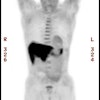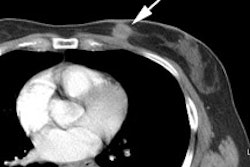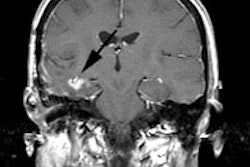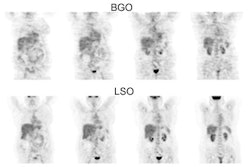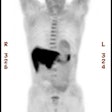Blood 1998 Jun 15;91(12):4464-71
Positron emission tomography in non-Hodgkin's lymphoma: assessment of
chemotherapy with fluorodeoxyglucose.
Romer W, Hanauske AR, Ziegler S, Thodtmann R, Weber W, Fuchs C, Enne W, Herz M,
Nerl C, Garbrecht M, Schwaiger M.
Positron emission tomography (PET) using F-18 fluorodeoxyglucose (FDG) was
performed in non-Hodgkin's lymphoma (NHL), which is known to be highly
responsive to chemotherapy, but also yields variable treatment results to answer
the following questions: (1) What is the extent and time course of changes in
FDG utilization in response to chemotherapy? (2) Are the changes of FDG uptake
at early time points of chemotherapy predictive for therapy outcome? (3) Which
quantitative FDG parameter provides the most sensitive measures of initial tumor
response? Dynamic PET scans were performed in 11 patients at baseline and 1 and
6 weeks after initiation of chemotherapy. Based on attenuation corrected images
acquired 30 to 60 minutes postinjection, standardized uptake values (SUV) were
determined. Arterial input functions were estimated from vascular F-18 activity
and the metabolic rates for FDG (MRFDG) were calculated using Patlak analysis.
Before chemotherapy, high FDG uptake was found in all lesions (SUV[max] 13.3 +/-
4.2). Seven days after initiation of chemotherapy, tumor FDG uptake decreased
60% (SUV[max]). A further decrease of 42% was seen at day 42 resulting in a
total decrease of 79% from baseline to day 42. During a follow-up of 16.0 +/-
4.2 months, six of the 11 patients continued to show complete remission. Seven
days after initiation of chemotherapy, this group of patients displayed
significantly lower mean MRFDG than the group of patients with relapse. At day
42, all parameters of FDG uptake showed a significant difference for both
patient groups. The relative change of MRFDG from baseline to day 42, as well as
from day 7 to day 42, was significantly larger as compared with SUV parameters.
Standard chemotherapy of patients with NHL causes rapid decrease of tumor FDG
uptake as early as 7 days after treatment, which continues to decline during
therapy, indicating the sensitivity of metabolic signals to chemotherapeutic
interventions. FDG uptake at 42 days after therapy was superior in prediction of
long-term outcome over day 7 parameters. Dynamic data acquisition combined with
Patlak analysis of FDG kinetics may provide superior information in therapy
monitoring.
